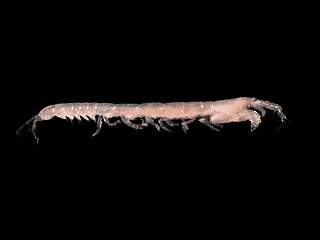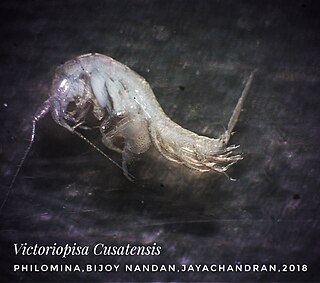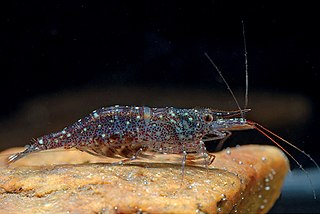
The crustacean order Tanaidacea make up a minor group within the class Malacostraca. There are about 940 species in this order.

Cumacea is an order of small marine crustaceans of the superorder Peracarida, occasionally called hooded shrimp or comma shrimp. Their unique appearance and uniform body plan makes them easy to distinguish from other crustaceans. They live in soft-bottoms such as mud and sand, mostly in the marine environment. There are more than 1,500 species of cumaceans formally described. The species diversity of Cumacea increases with depth.
Eucrenonaspides oinotheke is a species of crustacean in the family Psammaspididae, endemic to Tasmania, the only species described in the genus Eucrenonaspides. Eucrenonaspides is in the order Anaspidacea. It was described from a spring at 9 Payton Place, Devonport, Tasmania in 1980, making it "the first spring-dwelling syncarid recorded from the Australian region". It is listed as a vulnerable species on the IUCN Red List. A further undescribed species is known from south-western Tasmania.
Gynodiastylidae is one of the eight most commonly recognised families of crustaceans of the order Cumacea. They are especially prevalent in the southern hemisphere, with some types described from Japan, Thailand and the Persian Gulf. Most are found at less than 100 metres (330 ft) depth.
Lampropidae is a family of cold-water crustaceans belonging to the order Cumacea. Members of Lampropidae are relatively easily recognised because they all at have at least three terminal setae on the telson. The telson is medium to large and not fused with the last segment of the pleon. The endopods of the uropods are present on all three members. In the males the flagellum of the second antenna reaches beyond the carapace; moreover, they possess pleopods. In the females the second antenna is somewhat shorter than the first. There are exopods on the third maxilliped and strongly reduced or absent on the third pereopods.

Nototropis falcatus is a species of amphipod crustacean. It is whitish in colour, with brown patches, and grows to a total length of around 7 mm (0.3 in). It lives on soft sediment such as fine sand at depths of 10 to 50 metres, from northern Norway to the west coast of Ireland, including the North Sea, and as far south as the southern Bay of Biscay.

Stegocephalidae is a little-studied family of amphipods belonging to the suborder Gammaridea.
Periclimenes pholeter, is a species of shrimp belonging to the family Palaemonidae. The species is closest to Periclimenes indicus, P. obscurus and P. toloensis, resembling these species in the presence of an epigastric tooth on the carapace, the shape of the abdomen, the spinulation of the carapace, and the unarmed fingers of the first chelipeds. P. pholeter most resembles P. indicus by the elongatecarpus and long fingers of the second pereiopods, differing in these features from P. toloensis, which has the fingers slightly less than half as long as the palm. In P. obscurus the fingers are shorter than the palm, but the carpus is about as long as the palm. From P. indicus, this species differs: by the greater size; by the much higher rostrum and the greater number of ventral rostral teeth; by the shorter eye; by the less slender antennular peduncle; by the more deeply cleft upper antennular flagellum; by the more robust scaphocerite; by the fingers of the first pereiopods ; by the more slender pereiopods, especially the fifth, which is much longer than the ischium.
Aega antarctica is a species of isopod crustacean. It is a temporary ectoparasite of fish, feeding on the fish's blood and then dropping to the seabed to digest its meal over a period of several months. It is found in the seas around Antarctica.

Sinocorophium hangangense is a species of gammaridean amphipod found mainly in Korea. The species was found in the lower reaches of Han River in Gyeonggi-do, Korea. The shape of the first and the third uropods, the posterior appendages, alongside the relatively large size of the body distinguishes the Sinocorophium hangangense from other related species.
Luckia is a genus of amphipod crustaceans in the family Pontogeneiidae, with the sole species Luckia striki. It is found in hydrothermal vents in the Atlantic Ocean.

Necrogammarus salweyi is the binomial name applied to an arthropod fossil discovered in Herefordshire, England. The fossil represents a fragmentary section of the underside and an appendage of a pterygotid eurypterid, a group of large and predatory aquatic arthropods that lived from the late Silurian to the late Devonian. The Necrogammarus fossil is Late Silurian in age and its generic name means "dead lobster", deriving from Ancient Greek νεκρός and Latin gammarus ("lobster").

Victoriopisa cusatensis is a amphipod species in the family Eriopisidae. The species name ‘cusatensis’ refers to the Cochin University of Science and Technology (CUSAT). This species has been described by the team of researchers in 2018 from the Valanthakad mangrove area of Vembanad backwater.
Actogidiella is a monotypic genus of amphipod crustaceans. It contains only the species Actogidiella cultrifera. The genus' name derives from the Greek word for seacoast and the suffix -gidiella which refers to its habitat.

Armadillidium sfenthourakisi is a European species of woodlouse endemic to Greece.

Armadillidium petralonense is a European species of woodlouse endemic to Greece. It is a relatively medium-sized species that probably belongs to the so-called "Armadillidium fossuligerum complex".

Armadillidium jerrentrupi is a European species of woodlouse endemic to Greece. It is a relatively medium-sized species that probably belongs to the so-called "Armadillidium fossuligerum complex".

Paxodillidium is a genus of woodlice endemic to Greece. It is monotypic, being represented by the single species Paxodillidium schawalleri. Its true affinities within the family Armadillidiidae are not known.

Armadillidium stymphalicum is a European species of woodlouse endemic to Greece.

Caridina longidigita, also known as the Sulawesi fan shrimp, is a species of freshwater atyid shrimp.












